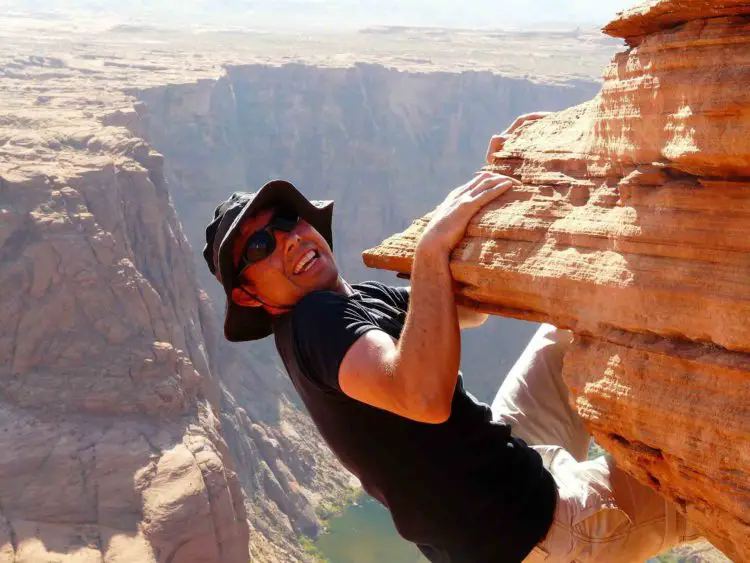Free solo climbing is a form of climbing where you don’t use ropes, harnesses, or any other protective equipment. It’s not the same as bouldering though where you’re at a safe height. This is the real deal, one of the most dangerous and extreme sports there is. It stands to reason that if you fall, you die.
How dangerous is free soloing?
Let’s put it this way: no injuries are really reported in this extreme sport because those who don’t make it have died. So, in short, free soloing is an extremely dangerous sport, one that has led to the untimely deaths of many experienced climbers.
What exactly is free solo climbing?
In a free solo climb, often called soloing, you’re climbing cliffs without using any climbing equipment, save for your rock shoes and chalk bag. You’re up there relying on your skills to climb to the top. It’s the ultimate challenge that only top climbers should ever attempt, and even then, the stakes are high. If you fall and live to tell about it, you risk injuries that will keep you from ever climbing again. And we know what happens if you we to fall. You die. This is perhaps the greatest reason why I will take a hard pass on trying it out.
Why would someone free solo climb?
High-profile climbers that have done a solo climb successfully have all explained that the reasons for it include the ease and agility along with speed you can climb without being encumbered by equipment. Alex Honnold is a perfect example of this, who took three hours and 50 minutes to scale up 2,224 feet on the Regular Northwest Face at Yosemite’s Half Dome.
It’s something that requires a spectacular amount of concentration, which is why routes are chosen that are familiar to the climbers and well within their difficulty level. But no matter how good a climber is, nature will always have the last word. Loose rocks or a sudden shift in the weather can turn a winning solo climb into a deadly ending.
Free soloing is as extreme and dangerous as it gets
If you’re looking to climb without gear, may I suggest bouldering at your climbing gym for a thrill? More experienced climbers will boulder in the wild, but even then, they’re always staying at safe heights, so if a problem arises, injuries aren’t severe.
With free soloing though, it stands to be the most dangerous extreme sport of them all. Even skydivers use parachutes, and bungee jumpers are tethered with a rope. But soloists use nothing except their climbing shoes, chalk, and pure faith that they can ascend without incident. Just one mistake on a solo climb and you’ll likely see a tumble of sky, clouds, and ground before you see nothing else at all.
Sorry for the drama, but I’m being honest here. What can you expect when you try to defy gravity without any systems in place to protect you if you fall? That’s why I’ll stick to climbing, thank-you-very-much. I like knowing that if I fall, I’m going to live to tell about it and I’m going to be able to perfect my technique without falling to my doom.
You might be an excellent climber, but no matter how good you are, there are no guarantees you’ll come back from that climb. It might be the last time you see the people you love, a very sobering thought. That’s why I put free soloing as the most dangerous sport on the planet. There are some things you can’t control while climbing. I know this because I’ve been on the crag and have been lucky to have solid gear connecting me and saving me from my missteps.
Once, I was stung by a bee while climbing! This caused me to let go and holler, “Falling!” Thankfully, all ended well for me, but if I’d decided to go for a free solo climb, I wouldn’t be here telling you all this.
I’d also like to be fair though and point out that not every free solo climb ends in death. Some choose to do these climbs from heights that aren’t fatal. You can see a lot of videos of that on YouTube, if you’re the grim sort. Most free soloists don’t consider these shams as real free solo climbs. By definition, a free solo climb is one where falling is not one of your options. Otherwise, you’re talking about bouldering. Even high-ball bouldering isn’t the same thing.
A free solo climb is just you and the rock. There’s no one there to help you. You’ll be there alone and the only way out is to keep going up or die alone while anyone nearby looks on in absolute horror.
Second chances are very rare in free solo climbing
Famed climber Max Zolotukhin is a rare breed indeed in that he was one of very few to have a second chance after making a big mistake during a free solo climb. About 10 years ago, his hand slipped from a hold at about 20 feet up. Video of this is about enough to put any sane person off to free solo climbing, but people like Zolotukhin that have a clear head and stay calm in the face of pressure are better at handling this sort of thing.
He was very lucky to survive and one of the few that ever had. He broke a lot of bones and had a huge recovery to endure after that. But generally speaking, you shouldn’t push your luck when it comes to solo climbing. Zolotukhin admits he was overconfident and assumptive he would be “ok”.
The thing is, it is incredible to watch a free soloist move on the rock. It’s a thing of beauty, but it’s also downright lunacy. What if you don’t make it? Then you die, doing something you love, yes, but you’ll never get to climb again. “Died doing what he loved” is not something I want on my tombstone. I think I’d like to go at an old age, where I’m so senile I recount the same climbing tales to my grandkids over and over again, until they beg me to stop and take them for ice cream.
Some of the biggest names in climbing decided to do free soloist climbs and met their death, which could have easily been avoided had they used safety ropes.
Notable free solo climbing accidents
One of the earliest known solo climbing accidents occurred in 1913. Paul Preuss was attempting to make the first ascent of the Mandlkogel in Gosaukamm. A wrong move sent him falling about 1,000 feet down to his death.
You’d think that his death would have been a warning to others to use their safety ropes and harnesses, but the next known notable free solo climbing accident happened in 1987 when Jimmy Jewell fell from Poor Man’s Peuterey in North Wales. The route was his shortcut from a nearby pub. He was trying to get to his climbing club hut. There’s not much other information about it, but one can assume that because it was below his usual grade and capacity that perhaps he’d had a bit too much to drink at that pub.
There was Derek Hersey who died after falling from the Steck-Salathé Route on Sentinel Rock in Yosemite National Park during his free solo. Dwight Bishop met his end, free soloing on Grand Teton peak on the Grand Traverse route in Wyoming. Jimmy Ray Forester’s story from 2006 hit me hardest though. This guy was an experienced and incredibly talented climber. He was one of the best. When he didn’t return to camp from the 40-pitch 5.9 ridge route, the Scariest Ride in the Park, which was known for loose rock, everyone went to look for him. And they found him the very next day, dead at the base of the wall.
These guys had everything going for them. They were experienced climbers. Yet, something happened to them up there that we’ll just never know. It could have been a bee like what happened to me, when I was safely tethered. The sun could’ve gotten in their eyes. They could have missed a hold, or their foot could have slipped. They could’ve stepped on a loose rock. Without safety equipment, you’re really at the mercy of Mother Nature and you’re one step away from knocking on heaven’s door.
George Gardner, John Bachar, Akihira Tawara, Michael Ybarra, Brad Parker, Andrew Barnes, Angus Moloney, and the most recent Ueli Steck, a famed Swiss mountaineer fell off the Nuptse Wall in 2017, plummeting over 3,200 feet. All of these guys died after Forester fell in 2006. It’s like no one learned, or they were too confident to think it could ever happen to them. They’d done this before, so they had a false sense of security that everything would be ok. Instead, these bright lights were extinguished too soon.
Real talk here: it’s not going to be ok if you fall from a free solo climb. Even if you live as Zolotukhin did, you’ll be in a world of hurt. Why take the chance when you can get the thrill of climbing safely? If you want to know what it’s like to fall, try bouldering at your gym. You’ll see if you land the wrong way, you’ll feel that ache for a few days. Now imagine doing that on rocks from further up. Yeah. It’s not the way I want my life to end either.
Conclusion
I can’t in good conscience ever encourage you or anyone to try a free solo climb. I have too many people to live for and too much else to do in this life than to throw it away trying to prove something. I don’t have to prove a thing. I can out-best my best with all my gear. I can enjoy the sport for its extreme nature without having to worry that if I slip and fall, my wife will be heartbroken for the rest of her life and our kids will have to grow up without me.
Get your thrills another way, so that you live to climb another day. Honestly, the thrill I get up on the crag is perfect the way it is, cumbersome equipment and all. I wouldn’t trade that for the world, and if I were to free solo, that would be the ultimate trade-off. Like playing with fire, it’s just not worth it to me to get burned. Always be safe climbing and take your challenges within stride. There’s no reason to die doing what you love. Live doing what you love and live it every day until you’re old and grey!

